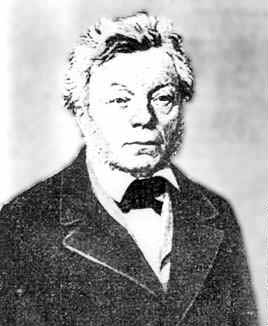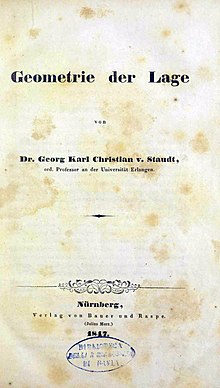カール・フォン・シュタウト
| カール・フォン・シュタウト | |
|---|---|
 Karl von Staudt (1798 - 1867) | |
| 生誕 |
1798年1月24日 ドイツ、ローテンブルク・オプ・デア・タウバー |
| 死没 |
1867年6月24日 エアランゲン |
| 国籍 | ドイツ |
| 研究分野 |
天文学 数学 |
| 出身校 | エアランゲン大学 |
| 博士課程 指導教員 | カール・フリードリヒ・ガウス |
| 主な業績 | フォン・シュタウト=クラウゼンの定理 |
| プロジェクト:人物伝 | |
カール・ゲオルグ・クリスティアン・フォン・シュタウト(独: Karl Georg Christian von Staudt、1798年1月24日 - 1867年6月1日)はドイツの数学者。総合幾何学の演算の基礎を築いた。
経歴と影響
[編集]シュタウトは、ローテンブルク・オプ・デア・タウバー(当時はローテンブルク帝国自由都市)に生まれた。1814年よりアンスバッハのギムナジウムで学んだ。1818年から1822年まで天文台長であったカール・フリードリヒ・ガウスの下でゲッティンゲン大学に通学した。この間にシュタウトは小惑星パラスと火星の軌跡の天体暦をもたらした。更に1821年、彗星Nicollet-Ponsを監視し、軌道要素をもたらした。この功績で、エアランゲン大学で、博士号を取得した。
シュタウトの専門職的な経歴は、1827年までヴュルツブルク、1835年でニュルンベルクの中等教育学校の講師経験がある。
1832年、Jeanette Dreschlerと結婚した。二人の間には息子Eduardと娘Mathildaが生まれた。Jeanetteは1848年没した。
書籍『Geometrie der Lage』(1847)は射影幾何学の代表的な書籍である。Burau (1976) は次のように書いている。
- Staudt was the first to adopt a fully rigorous approach. Without exception his predecessors still spoke of distances, perpendiculars, angles and other entities that play no role in projective geometry.[1]
更に、この本の43頁には完全四辺形を用いた射影調和共役の構築が載せられている。
1889年、マリオ・ピエリをシュタウトのこの書籍を翻訳し『I Principii della Geometrie di Posizione Composti in un Systema Logico-deduttivo 』(1898)を著作した。1900年にはブリンマー大学のシャーロット・スコットは、雑誌Mathematical Gazetteへ、シュタウトの多くの作品を英語に翻訳した[2]。1948年のヴィルヘルム・ブラシュケの教科書『Projective Geometry』のVorwortには、若かりし頃のシュタウトの肖像が飾られている。
シュタウトは、1856年-1860年に出版された『Beiträge zur Geometrie der Lage』の3巻で、実射影幾何学を複素射影空間へ拡張した。
1922年にヘンリー・フレデリック・ベイカーはシュタウトの功績について、次のように書いている。
- It was von Staudt to whom the elimination of the ideas of distance and congruence was a conscious aim, if, also, the recognition of the importance of this might have been much delayed save for the work of Cayley and Klein upon the projective theory of distance. Generalised, and combined with the subsequent Dissertation of Riemann, v. Staudt's volumes must be held to be the foundation of what, on its geometrical side, the Theory of Relativity, in Physics, may yet become.[3]
シュタウトはまた、円錐曲線と極と極線について重要な見解を示していた。
- Von Staudt made the important discovery that the relation which a conic establishes between poles and polars is really more fundamental than the conic itself, and can be set up independently. This "polarity" can then be used to define the conic, in a manner that is perfectly symmetrical and immediately self-dual: a conic is simply the locus of points which lie on their polars, or the envelope of lines which pass through their poles. Von Staudt's treatment of quadrics is analogous, in three dimensions.[4]
Throw
[編集]1857年、『Beiträge zur Geometrie der Lage』の2巻において、シュタウトはthrows(ドイツ語: Wurftheorie)と呼ばれる概念を発明した。これは射影調和共役と射影領域に深く関連している。ヴェブレンとヤングの射影幾何学の教科書の6章では、点の乗法と加法を通して、"Algebra of points"と呼ばれる点を得ている。throwの概念は、複比とも深く関連する。ジュリアン・クーリッジは次のように書いている[5]。
- How do we add two distances together? We give them the same starting point, find the point midway between their terminal points, that is to say, the harmonic conjugate of infinity with regard to their terminal points, and then find the harmonic conjugate of the initial point with regard to this mid-point and infinity. Generalizing this, if we wish to add throws (CA,BD) and (CA,BD' ), we find M the harmonic conjugate of C with regard to D and D' , and then S the harmonic conjugate of A with regard to C and M:
- In the same way we may find a definition of the product of two throws. As the product of two numbers bears the same ratio to one of them as the other bears to unity, the ratio of two numbers is the cross ratio which they as a pair bear to infinity and zero, so Von Staudt, in the previous notation, defines the product of two throws by
- These definitions involve a long series of steps to show that the algebra so defined obeys the usual commutative, associative, and distributive laws, and that there are no divisors of zero.
ヴェブレンとヤングの定理10には次のような要約がある[6]。
The set of points on a line, with removed, forms a field with respect to the operations previously defined.
更には次のような記述もある[7]。
- ...up to Hilbert, there is no other example for such a direct derivation of the algebraic laws from geometric axioms as found in von Staudt's Beiträge.
シュタウトの調和共役の功績の肯定的な評価には次のようなものがある。
- The only one-to-one correspondence between the real points on a line which preserves the harmonic relation between four points is a non-singular projectivity.[8]
throwsはジョン・スティルウェル(2005)によって"projective arithmetic"と表現されている[9]。また、次のセクション"Projective arithmetic"には以下の記述がある。
- The real difficulty is that the construction of a + b , for example, is different from the construction of b + a, so it is a "coincidence" if a + b = b + a. Similarly it is a "coincidence" if ab = ba, of any other law of algebra holds. Fortunately, we can show that the required coincidences actually occur, because they are implied by certain geometric coincidences, namely the Pappus and Desargues theorems.
シュタウトの実数の構成法に関する功績は不完全であった。その一つの問題は、有界な数列が密集点を持たなければならないという点である。 ハンス・フロイデンタールは次のように言及した。
- To be able to consider von Staudt's approach as a rigorous foundation of projective geometry, one need only add explicitly the topological axioms which are tacitly used by von Staudt. ... how can one formulate the topology of projective space without the support of a metric? Von Staudt was still far from raising this question, which a quarter of a century later would become urgent. ... Felix Klein noticed the gap in von Staudt's approach; he was aware of the need to formulate the topology of projective space independently of Euclidean space.... the Italians were the first to find truly satisfactory solutions for the problem of a purely projective foundation of projective geometry, which von Staudt had tried to solve.[7]
実射影平面の輪環の順を研究した数学者の一人に、イタリアの数学者ジョバンニ・ヴァイラーティがいる。この順の科学には、分離関係と呼ばれる四元関係が要求される。この関係を用いて、単調数列と極限の概念が循環的な"line"で処理できる。すべての単調数列は極限値を持ち[10]、"line"は完備空間になる。これらの発展は、射影幾何学のの公理の性質を取り出す動きとして、シュタウトの可換体の公理の演繹は触発された。
作品
[編集]
- 1831: Über die Kurven, 2. Ordnung. Nürnberg
- 1845: De numeris Bernoullianis: commentationem alteram pro loco in facultate philosophica rite obtinendo, Carol. G. Chr. de Staudt. Erlangae: Junge.
- 1845: De numeris Bernoullianis: loci in senatu academico rite obtinendi causa commentatus est, Carol. G. Chr. de Staudt. Erlangae: Junge.
以下はコーネル大学のHistorical Mathematical Monographsへのリンク。
- 1847: Geometrie der Lage. Nürnberg.
- 1856: Beiträge zur Geometrie der Lage, Erstes Heft. Nürnberg.
- 1857: Beiträge zur Geometrie der Lage, Zweites Heft. Nürnberg.
- 1860: Beiträge zur Geometrie der Lage, Drittes Heft. Nürnberg.
関連項目
[編集]出典
[編集]- ^ Walter Burau (1976) "Karl Georg Christian von Staudt", Dictionary of Scientific Biography, auspices of American Council of Learned Societies
- ^ Charlotte Scott (1900) "On von Staudt's Geometrie der Lage", The Mathematical Gazette 1(19):307–14, 1(20):323–31, 1(22):363–70
- ^ H. F. Baker (1922) Principles of Geometry, volume 1, page176, Cambridge University Press
- ^ H.S.M. Coxeter (1942) Non-Euclidean Geometry, pp 48,9, University of Toronto Press
- ^ J. L. Coolidge (1940) A History of Geometrical Methods, pages 100, 101, Oxford University Press
- ^ Veblen & Young page 141
- ^ a b Hans Freudenthal (1974) "The Impact of Von Staudt's Foundations of Geometry", in For Dirk Struik, R.S. Cohen editor, D. Reidel. Also found in Geometry – von Staudt's Point of View, Peter Plaumann & Karl Strambach editors, Proceedings of NATO Advanced Study Institute, Bad Windsheim, July/August 1980, D. Reidel, ISBN 90-277-1283-2
- ^ Dirk Struik (1953) Lectures on Analytic and Projective Geometry, p 22, "theorem of von Staudt"
- ^ Stillwell, John (2005). The Four Pillars of Geometry. Springer. p. 128. doi:10.1007/0-387-29052-4_6
- ^ H. S. M. Coxeter (1949) The Real Projective Plane, Chapter 10: Continuity, McGraw Hill
- O'Connor, John J.; Robertson, Edmund F., “Karl George Christian von Staudt”, MacTutor History of Mathematics archive, University of St Andrews.
- Veblen, Oswald; Young, J. W. A. (1938). Projective geometry. Boston: Ginn & Co.. ISBN 978-1-4181-8285-4
- John Wesley Young (1930) Projective Geometry, Chapter 8: Algebra of points and the introduction of analytic methods, Open Court for Mathematical Association of America.




